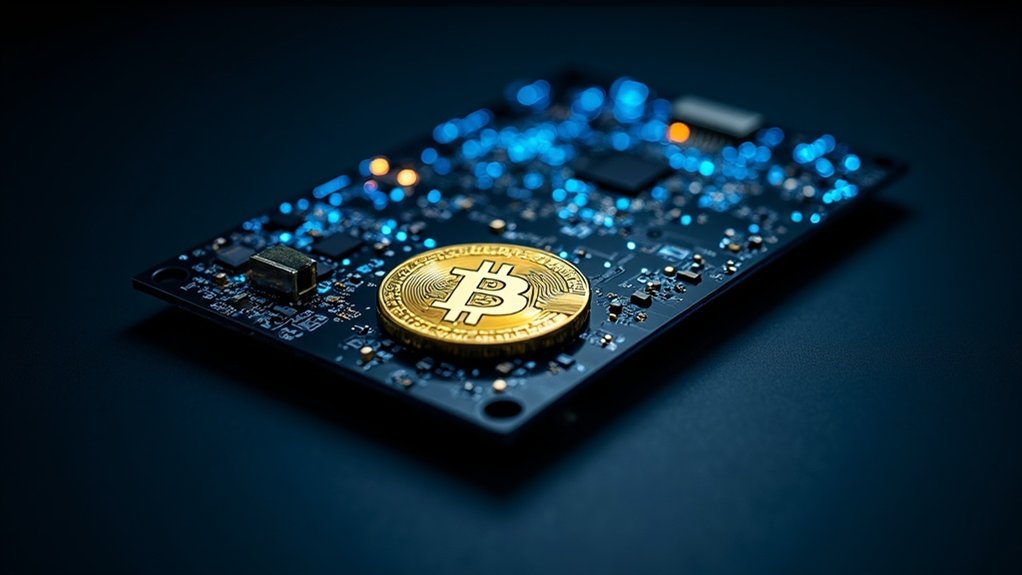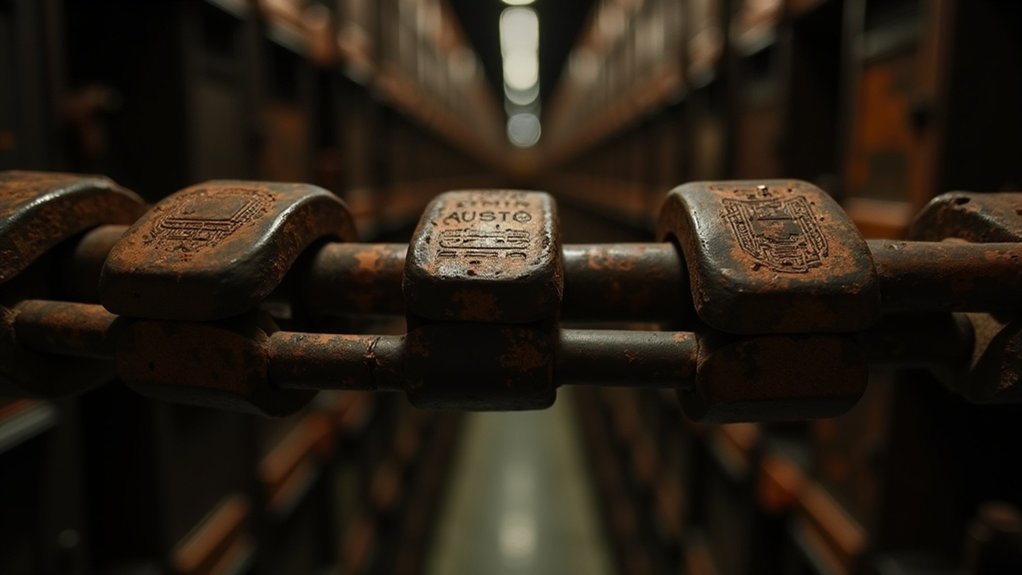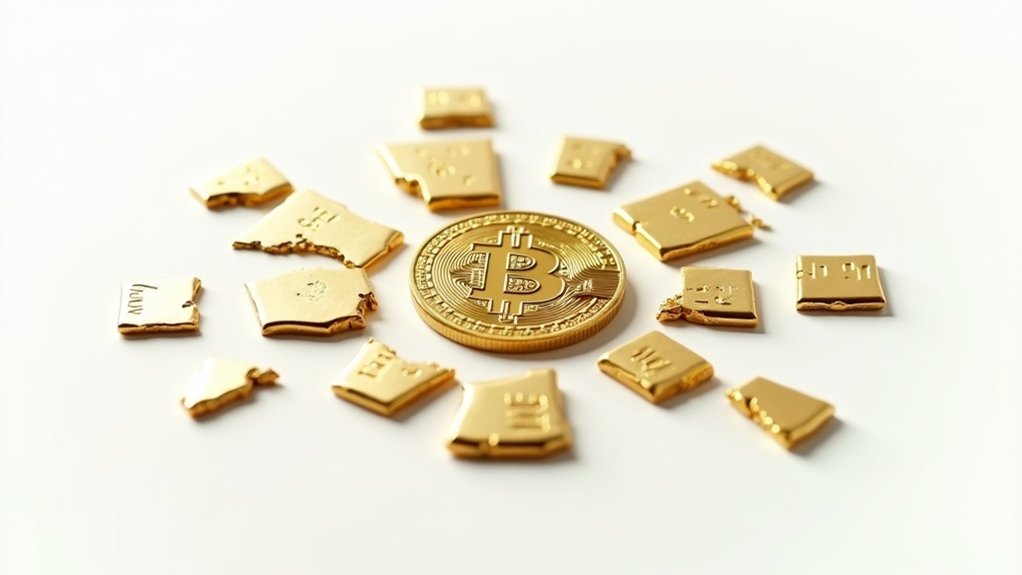Bitcoin isn’t made of anything physical. It’s purely digital code existing on a blockchain network. Those golden coins in photos? Complete fiction. Bitcoin operates through cryptographic algorithms solved by miners who validate transactions. No central authority controls it. The entire system runs on mathematics and distributed computing power, not atoms or metal. Physical “Bitcoins” are just collectible tokens with embedded QR codes or private keys. The reality of digital currency goes deeper than meets the eye.
Three misconceptions plague Bitcoin discussions, especially about what these digital assets are actually made of.
No, Bitcoin isn’t a shiny metal coin with a fancy “B” logo. It’s not some magical internet money appearing out of thin air. And it’s definitely not something you can hold in your hand—at least not really. Bitcoin exists purely as digital records on something called a blockchain. That’s it. Just lines of code secured by sophisticated cryptography and maintained across thousands of computers worldwide. No physical substance whatsoever.
Bitcoin relies entirely on math. Complex mathematical algorithms and cryptographic puzzles form its backbone. Miners solve these puzzles to validate transactions, currently earning 6.25 BTC for their computational efforts. The whole system operates without a central authority. No banks. No governments. Just peer-to-peer networks crunching numbers 24/7. This decentralized structure is what makes Bitcoin revolutionary, not any physical properties. Unlike traditional currencies that are government-issued money, Bitcoin operates independently of any central bank control. The digital wallet system allows users to transfer Bitcoin directly between each other without intermediaries.
The magic of Bitcoin lies in its mathematical foundation—cryptographic puzzles solved by decentralized networks, not governments or banks.
Those golden coins you see in stock photos? Complete fiction. Though, ironically, physical Bitcoin representations do exist. These are typically metal tokens containing embedded private keys or QR codes linked to actual digital Bitcoin. Think of them as fancy USB drives shaped like coins. They’re collectors’ items, sometimes made from precious metals, with value often exceeding the digital Bitcoin they represent. Pretty weird when you think about it.
The differences between digital and physical assets matter. Digital Bitcoin transfers instantly across borders. Physical assets need trucks, planes, or pockets. Digital Bitcoin security means protecting private keys—essentially long passwords. Physical security means vaults and armed guards. The pioneering Casascius coins, created in 2011, were among the first physical representations but ceased production in 2013 due to regulatory challenges.
Bitcoin can be divided into tiny fractions (ever heard of a satoshi?). Try cutting a gold coin into a million pieces.
Bottom line: Bitcoin is made of math, cryptography, and consensus. Not atoms. The network exists across computers globally, maintained by miners solving puzzles. Your Bitcoin “wallet” just holds keys proving ownership of entries in a digital ledger. That’s it. No physical substance required.
Frequently Asked Questions
Can I Touch or Hold Bitcoins Physically?
No, you can’t physically touch or hold actual Bitcoins.
They’re just digital code on a blockchain. Nothing tangible about them.
Some people make physical coins as collectibles or novelties, but these aren’t real Bitcoins.
The Casascius coins were an exception—physical tokens with embedded private keys to access real Bitcoin value. Production stopped in 2013.
Bottom line: true Bitcoin exists only as digital records.
Any physical “Bitcoin” is just a representation, not the real deal.
How Do Bitcoins Gain Real-World Value?
Bitcoins gain value through pure supply and demand. Period. Their fixed cap of 21 million creates scarcity—unlike endlessly printable dollars.
Investors see it as “digital gold,” a hedge against inflation. Trust matters too. The more people believe in Bitcoin’s utility for borderless transactions, the more valuable it becomes.
Network effects kick in; more users equals more value. No backing from governments or gold necessary. Just collective agreement that these digital tokens matter.
Are Bitcoins Backed by Any Government or Commodity?
No, bitcoins aren’t backed by any government or commodity. That’s kind of the point.
Unlike the dollar or euro, no central authority guarantees bitcoin’s value.
However, in March 2025, the U.S. established a Strategic Bitcoin Reserve, becoming one of the first governments to hold bitcoin as a reserve asset.
The CFTC classifies bitcoin as a commodity, not a currency.
Still, bitcoin remains fundamentally decentralized.
Its value? Pure supply and demand.
No gold bars. No government promises.
What Happens to Bitcoins if the Internet Crashes?
Bitcoins remain intact during internet outages.
The decentralized blockchain ledger stays preserved across thousands of nodes worldwide.
No coins vanish. No data gets erased.
Users simply can’t access or transfer their coins until connectivity returns.
Once back online, previously offline nodes sync up with the network, downloading missed data.
Some clever workarounds exist – satellite transmissions, SMS wallets, and mesh radio networks can process transactions without traditional internet.
Not perfect solutions, but they work.
How Secure Are Bitcoins Against Theft or Hacking?
Bitcoin security depends entirely on user practices.
The technology itself? Extremely secure. But humans are the weak link.
Two-factor authentication, hardware wallets, and strong passwords are essential. Hackers don’t break Bitcoin’s code—they break people’s terrible habits.
Major vulnerabilities include phishing scams, exchange hacks, and software exploits. Crypto bridges are particularly juicy targets.
The blockchain’s virtually unhackable, but your exchange account? Not so much if you’re using “password123.”









